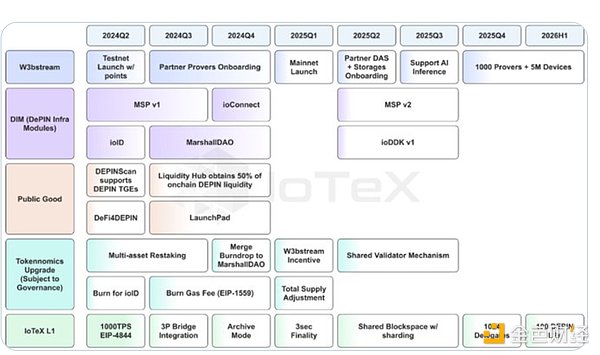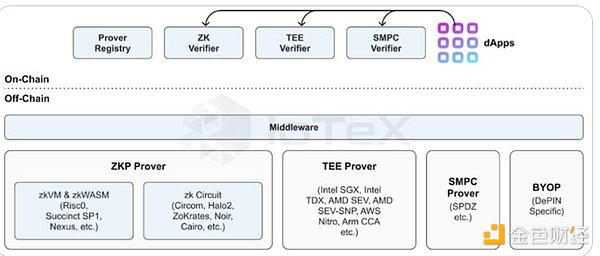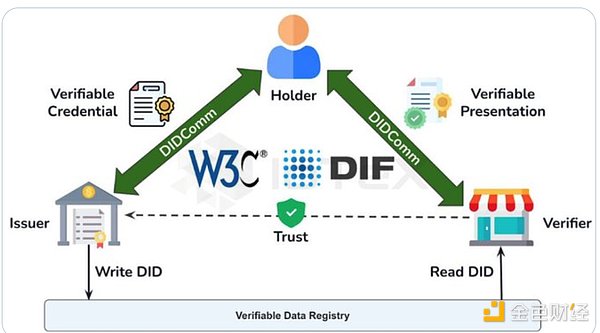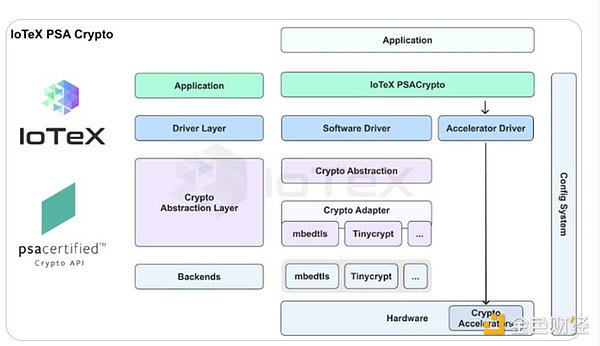Source: Chen Jian Source: X, @jason_chen998
Fully Circulated Depin Leader IoTex Releases Version 2.0
Today, as the fully circulated Depin leader, IoTex officially released version 2.0. It has been 7 years since the release of version 1.0. The new version of the white paper is rich in content, reflecting the team's strong willingness to do things. As shown in the Roadmap below, the main tone of version 2.0 is to completely upgrade the original IoT Layer1 public chain to a complete set of Depin solutions and open platform systems, which is also in line with the concept of this 2.0 "AI and DePIN for everyone". Although it seems that it only supports building Layer2 on top of IoTex like OP, the specific improvements are far more than that, mainly including four parts: W3bstream, DIM, Public Good, and economic model.

W3bstream: Off-chain Calculation and Authentication
As a Depin public chain, the most important responsibility is to ensure that the workload of many devices under the chain is authentic and reliable, and upload it to the chain in time to complete authentication and reward distribution. W3bstream claims to be the world's first decentralized off-chain computing network. It generates proofs of real-world activities in real time through ZK, fully homomorphic encryption, trusted execution environment, and multi-party computing, and publishes these proofs on the chain to reward device holders. In order to achieve rapid computing, IoTex's latest paper has improved the performance of ZKP by 30%, making it the world's fastest zkSNARK prover. W3bstream can also be used for off-chain AI computing and to ensure the credibility of the computing process and build AI data sets, which is similar to AO's position. In addition, it is also necessary to ensure the consistency of on-chain wallets and off-chain devices, and the uniformity of hardware device access. There are corresponding solutions in the subsequent DIM.

DIM: Modular Infrastructure
DIM (Depin Infra Modules) provides out-of-the-box capabilities for Depin projects through a series of modular methods, first including the MSP modular security pool, to create a unified trusted layer for Depin infrastructure, so that L2 can start faster. Since Depin includes a lot of on-chain and off-chain content at the same time, it needs to build its own decentralized architecture from scratch to improve credibility. MSP can be understood as the Eigenlayer in the Depin field, including three roles: DIM builders, pledgers, and validators. Among them, the builders are the most important, that is, the data flow, processing, storage, automation and other modules built by third-party developers for Depin. MSP provides a bribery mechanism to ensure that pledgers can get enough incentives from it.
The existence of ioID is also to solve the identity inconsistency problem caused by the interaction of a large number of on-chain addresses and off-chain devices in the Depin field. ioID uses the wallet address as the on-chain identity and the DID as the off-chain identity, and maps and associates them. The identity authentication of off-chain devices is a difficult point because there are many types of devices. In ioID, Depin devices can generate DIDs directly in the device instantly by integrating the IoTex SDK, that is, creating an NFT for each device. Users log in to the website through MetaMask and deposit a minimum of 10 IOTX Tokens as the gas fee during the device startup process. After the device generates the DID, the corresponding DID is read on the website and bound and registered, thereby realizing the association between the on-chain and off-chain.

ioConnect: Universal Embedded SDK
ioConnect is a universal embedded SDK that eliminates the complexity of Depin hardware devices. Although ioID can generate DIDs for various types of hardware, the problem of a wide variety of hardware devices and chips and inconsistent standards still exists. To this end, IoTex has developed a more universal standard SDK to facilitate hardware devices to connect to the Internet.

ioDDK: Building L2 Application Chain
At the end of DIM is ioDDK, which allows the Depin project to build L2 application chain based on IoTex and inherit the security of IoTex. In the years since IoTex went online, there has not been a single downtime accident or hacker theft.
In addition to the modular components provided by DIM, IoTex also provides DePinScan in the Public Good field, which allows users, miners and investors to monitor the growth of Depin projects and discover early projects. DePin Liquidity Hubs is a Dex dedicated to Depin Token, providing liquidity for early Depin projects.
Economic Model: Inflation and Deflation Mechanisms
Finally, the economic model is adjusted. In version 2.0, IoTex has both inflation and deflation mechanisms to form a dynamic balance hedge. In terms of inflation, IoTex's staking nodes will receive corresponding tokens as rewards. At the same time, IoTex introduced a Gas burning deflation mechanism similar to Ethereum in 2.0, and a certain number of tokens also need to be destroyed when using ioID to create an on-chain identity for a device. If the IoTex network can achieve good growth at the business level, a positive flywheel will be formed. The more people use it, the more tokens will be destroyed.
 JinseFinance
JinseFinance
 JinseFinance
JinseFinance JinseFinance
JinseFinance JinseFinance
JinseFinance JinseFinance
JinseFinance JinseFinance
JinseFinance JinseFinance
JinseFinance JinseFinance
JinseFinance Jixu
Jixu Coinlive
Coinlive  CryptoSlate
CryptoSlate